400846: Report on Increasing Hand Washing Compliance in Hospitals
VerifiedAdded on 2022/12/23
|18
|4541
|1
Report
AI Summary
This report examines the critical importance of improving hand washing compliance within hospital settings to prevent the spread of communicable diseases. It emphasizes the pivotal role of leaders in driving this change, discussing their responsibilities in performance improvement strategies, stakeholder engagement, and the implementation of change models like Kotter's 8-step approach. The report explores various leadership styles, particularly transformational leadership, and its impact on fostering a culture of hygiene. It analyzes the influence of workplace culture as a facilitator or barrier to change, providing management strategies to overcome resistance and promote a positive environment. The report also highlights the significance of benchmarking best practices and strategies for involving stakeholders. It concludes by underscoring the need for continuous improvement and the leader's commitment to sustain positive changes in hand hygiene practices.
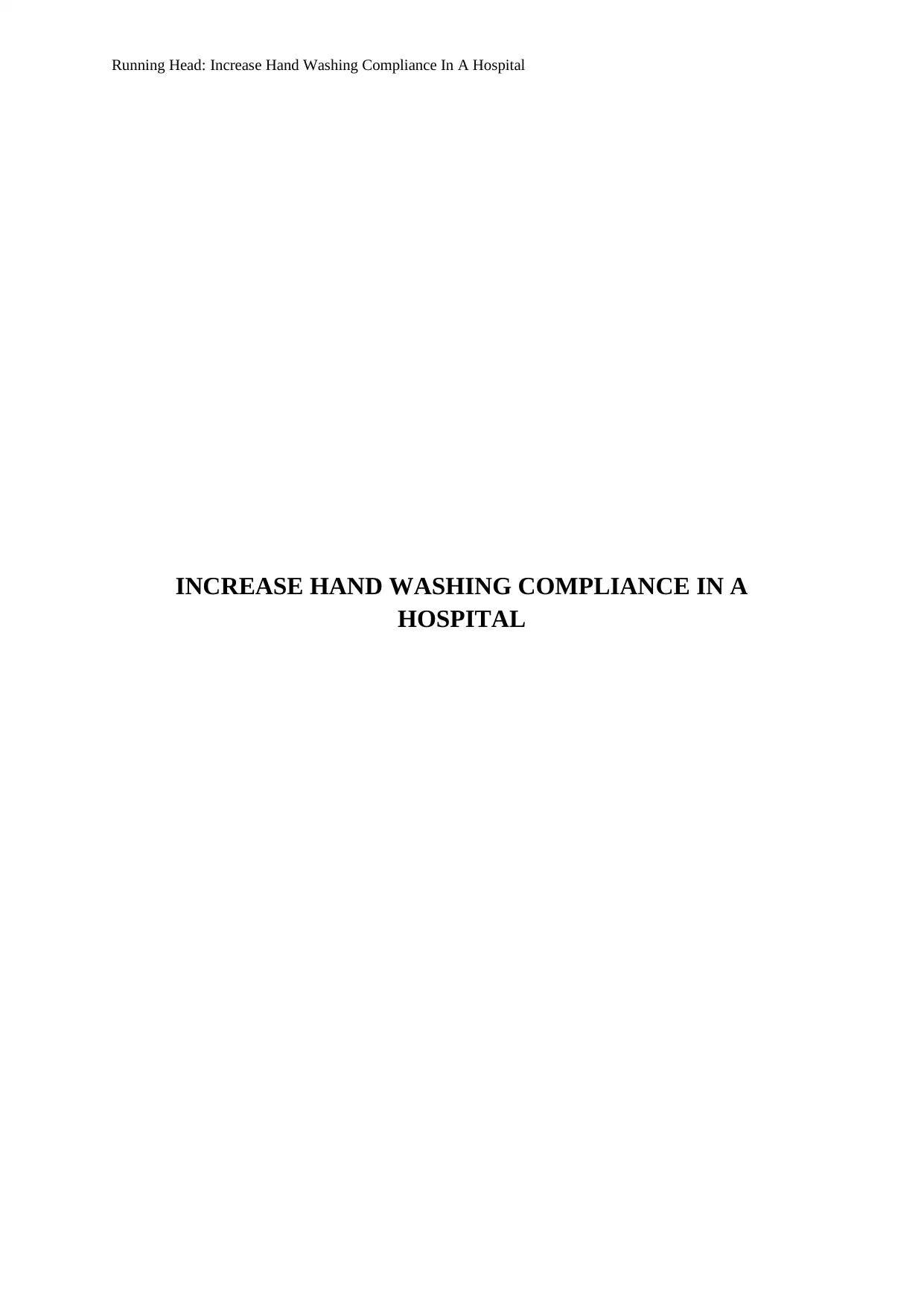
Running Head: Increase Hand Washing Compliance In A Hospital
INCREASE HAND WASHING COMPLIANCE IN A
HOSPITAL
INCREASE HAND WASHING COMPLIANCE IN A
HOSPITAL
Paraphrase This Document
Need a fresh take? Get an instant paraphrase of this document with our AI Paraphraser
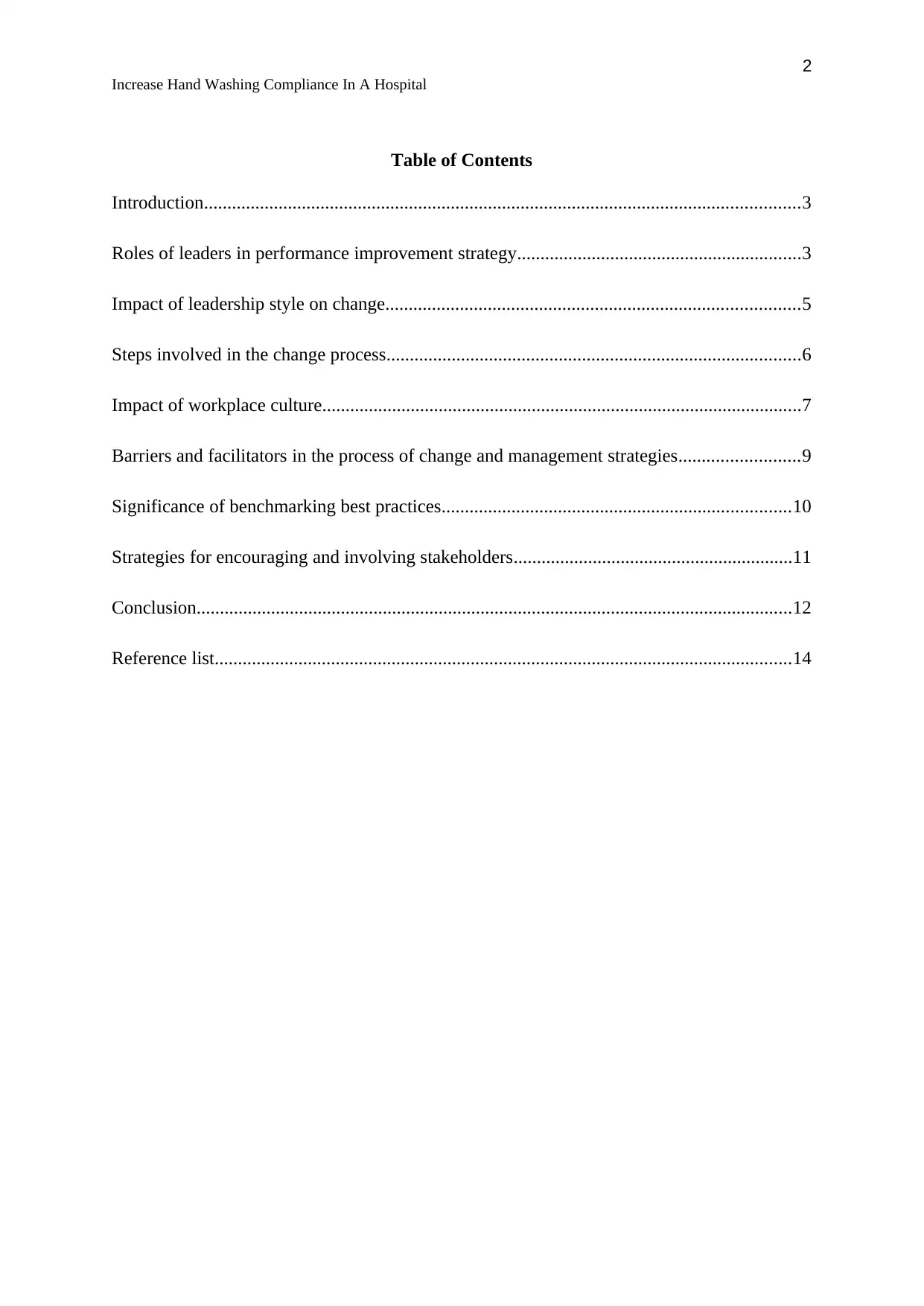
2
Increase Hand Washing Compliance In A Hospital
Table of Contents
Introduction................................................................................................................................3
Roles of leaders in performance improvement strategy.............................................................3
Impact of leadership style on change.........................................................................................5
Steps involved in the change process.........................................................................................6
Impact of workplace culture.......................................................................................................7
Barriers and facilitators in the process of change and management strategies..........................9
Significance of benchmarking best practices...........................................................................10
Strategies for encouraging and involving stakeholders............................................................11
Conclusion................................................................................................................................12
Reference list............................................................................................................................14
Increase Hand Washing Compliance In A Hospital
Table of Contents
Introduction................................................................................................................................3
Roles of leaders in performance improvement strategy.............................................................3
Impact of leadership style on change.........................................................................................5
Steps involved in the change process.........................................................................................6
Impact of workplace culture.......................................................................................................7
Barriers and facilitators in the process of change and management strategies..........................9
Significance of benchmarking best practices...........................................................................10
Strategies for encouraging and involving stakeholders............................................................11
Conclusion................................................................................................................................12
Reference list............................................................................................................................14
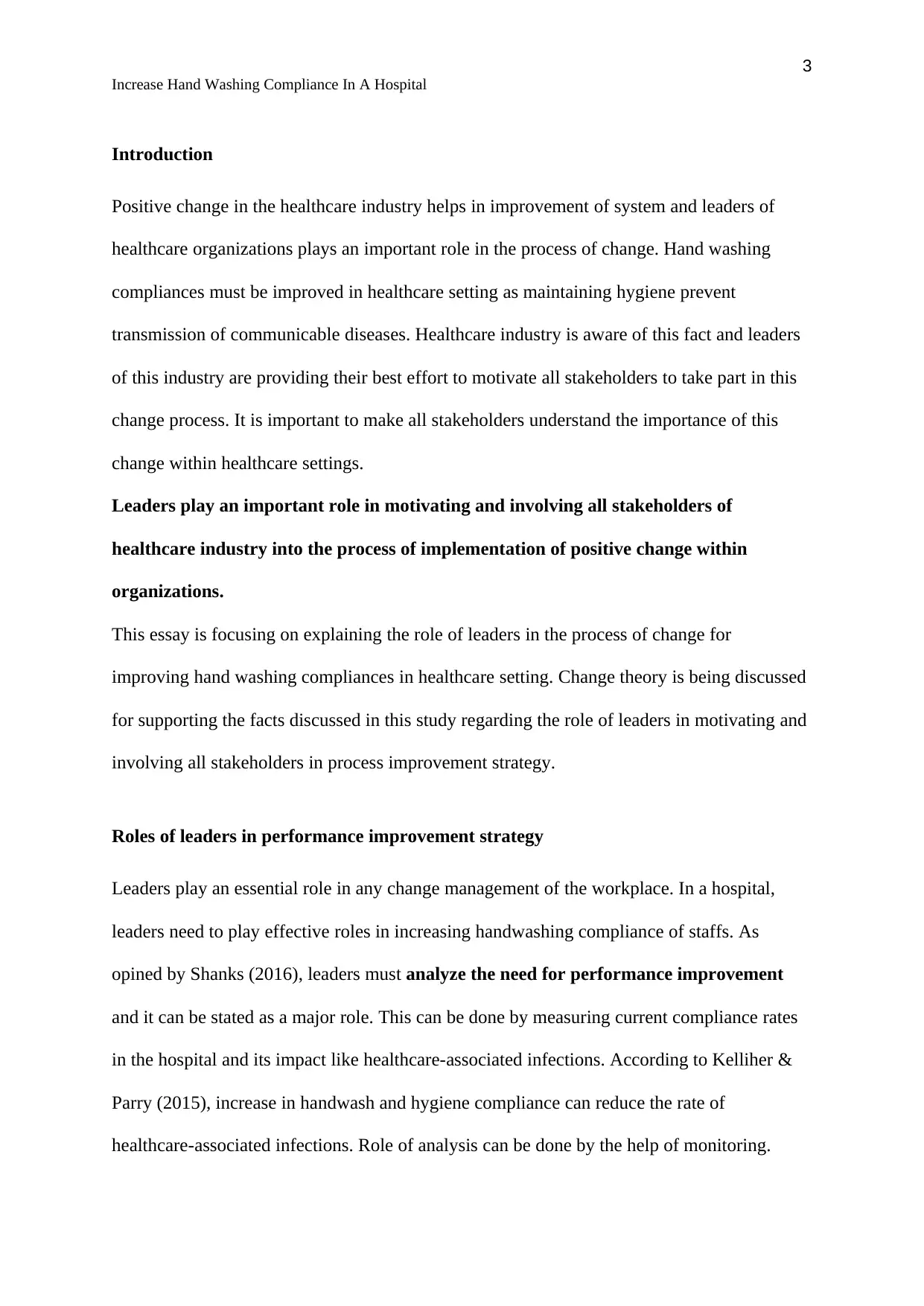
3
Increase Hand Washing Compliance In A Hospital
Introduction
Positive change in the healthcare industry helps in improvement of system and leaders of
healthcare organizations plays an important role in the process of change. Hand washing
compliances must be improved in healthcare setting as maintaining hygiene prevent
transmission of communicable diseases. Healthcare industry is aware of this fact and leaders
of this industry are providing their best effort to motivate all stakeholders to take part in this
change process. It is important to make all stakeholders understand the importance of this
change within healthcare settings.
Leaders play an important role in motivating and involving all stakeholders of
healthcare industry into the process of implementation of positive change within
organizations.
This essay is focusing on explaining the role of leaders in the process of change for
improving hand washing compliances in healthcare setting. Change theory is being discussed
for supporting the facts discussed in this study regarding the role of leaders in motivating and
involving all stakeholders in process improvement strategy.
Roles of leaders in performance improvement strategy
Leaders play an essential role in any change management of the workplace. In a hospital,
leaders need to play effective roles in increasing handwashing compliance of staffs. As
opined by Shanks (2016), leaders must analyze the need for performance improvement
and it can be stated as a major role. This can be done by measuring current compliance rates
in the hospital and its impact like healthcare-associated infections. According to Kelliher &
Parry (2015), increase in handwash and hygiene compliance can reduce the rate of
healthcare-associated infections. Role of analysis can be done by the help of monitoring.
Increase Hand Washing Compliance In A Hospital
Introduction
Positive change in the healthcare industry helps in improvement of system and leaders of
healthcare organizations plays an important role in the process of change. Hand washing
compliances must be improved in healthcare setting as maintaining hygiene prevent
transmission of communicable diseases. Healthcare industry is aware of this fact and leaders
of this industry are providing their best effort to motivate all stakeholders to take part in this
change process. It is important to make all stakeholders understand the importance of this
change within healthcare settings.
Leaders play an important role in motivating and involving all stakeholders of
healthcare industry into the process of implementation of positive change within
organizations.
This essay is focusing on explaining the role of leaders in the process of change for
improving hand washing compliances in healthcare setting. Change theory is being discussed
for supporting the facts discussed in this study regarding the role of leaders in motivating and
involving all stakeholders in process improvement strategy.
Roles of leaders in performance improvement strategy
Leaders play an essential role in any change management of the workplace. In a hospital,
leaders need to play effective roles in increasing handwashing compliance of staffs. As
opined by Shanks (2016), leaders must analyze the need for performance improvement
and it can be stated as a major role. This can be done by measuring current compliance rates
in the hospital and its impact like healthcare-associated infections. According to Kelliher &
Parry (2015), increase in handwash and hygiene compliance can reduce the rate of
healthcare-associated infections. Role of analysis can be done by the help of monitoring.
⊘ This is a preview!⊘
Do you want full access?
Subscribe today to unlock all pages.

Trusted by 1+ million students worldwide
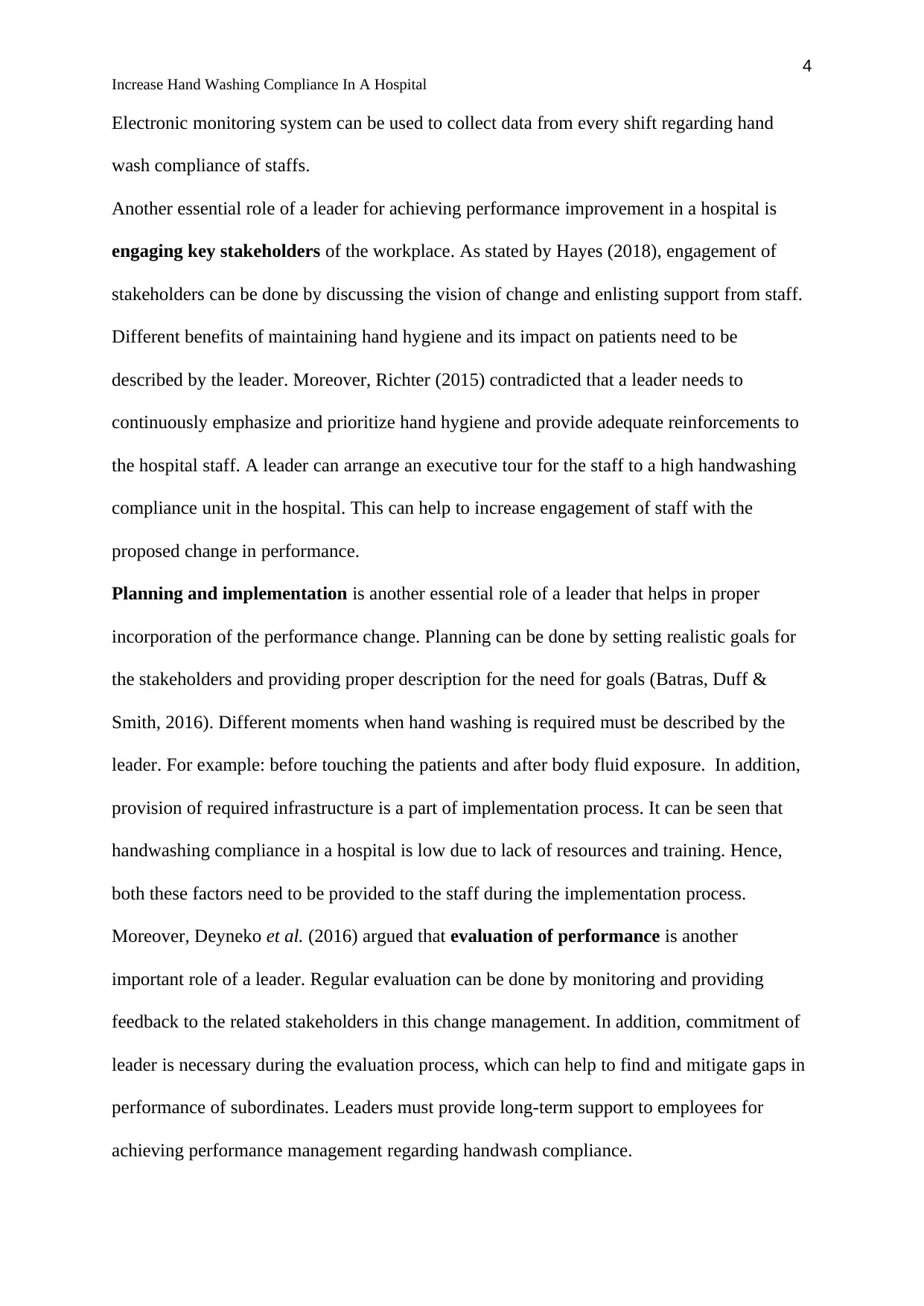
4
Increase Hand Washing Compliance In A Hospital
Electronic monitoring system can be used to collect data from every shift regarding hand
wash compliance of staffs.
Another essential role of a leader for achieving performance improvement in a hospital is
engaging key stakeholders of the workplace. As stated by Hayes (2018), engagement of
stakeholders can be done by discussing the vision of change and enlisting support from staff.
Different benefits of maintaining hand hygiene and its impact on patients need to be
described by the leader. Moreover, Richter (2015) contradicted that a leader needs to
continuously emphasize and prioritize hand hygiene and provide adequate reinforcements to
the hospital staff. A leader can arrange an executive tour for the staff to a high handwashing
compliance unit in the hospital. This can help to increase engagement of staff with the
proposed change in performance.
Planning and implementation is another essential role of a leader that helps in proper
incorporation of the performance change. Planning can be done by setting realistic goals for
the stakeholders and providing proper description for the need for goals (Batras, Duff &
Smith, 2016). Different moments when hand washing is required must be described by the
leader. For example: before touching the patients and after body fluid exposure. In addition,
provision of required infrastructure is a part of implementation process. It can be seen that
handwashing compliance in a hospital is low due to lack of resources and training. Hence,
both these factors need to be provided to the staff during the implementation process.
Moreover, Deyneko et al. (2016) argued that evaluation of performance is another
important role of a leader. Regular evaluation can be done by monitoring and providing
feedback to the related stakeholders in this change management. In addition, commitment of
leader is necessary during the evaluation process, which can help to find and mitigate gaps in
performance of subordinates. Leaders must provide long-term support to employees for
achieving performance management regarding handwash compliance.
Increase Hand Washing Compliance In A Hospital
Electronic monitoring system can be used to collect data from every shift regarding hand
wash compliance of staffs.
Another essential role of a leader for achieving performance improvement in a hospital is
engaging key stakeholders of the workplace. As stated by Hayes (2018), engagement of
stakeholders can be done by discussing the vision of change and enlisting support from staff.
Different benefits of maintaining hand hygiene and its impact on patients need to be
described by the leader. Moreover, Richter (2015) contradicted that a leader needs to
continuously emphasize and prioritize hand hygiene and provide adequate reinforcements to
the hospital staff. A leader can arrange an executive tour for the staff to a high handwashing
compliance unit in the hospital. This can help to increase engagement of staff with the
proposed change in performance.
Planning and implementation is another essential role of a leader that helps in proper
incorporation of the performance change. Planning can be done by setting realistic goals for
the stakeholders and providing proper description for the need for goals (Batras, Duff &
Smith, 2016). Different moments when hand washing is required must be described by the
leader. For example: before touching the patients and after body fluid exposure. In addition,
provision of required infrastructure is a part of implementation process. It can be seen that
handwashing compliance in a hospital is low due to lack of resources and training. Hence,
both these factors need to be provided to the staff during the implementation process.
Moreover, Deyneko et al. (2016) argued that evaluation of performance is another
important role of a leader. Regular evaluation can be done by monitoring and providing
feedback to the related stakeholders in this change management. In addition, commitment of
leader is necessary during the evaluation process, which can help to find and mitigate gaps in
performance of subordinates. Leaders must provide long-term support to employees for
achieving performance management regarding handwash compliance.
Paraphrase This Document
Need a fresh take? Get an instant paraphrase of this document with our AI Paraphraser
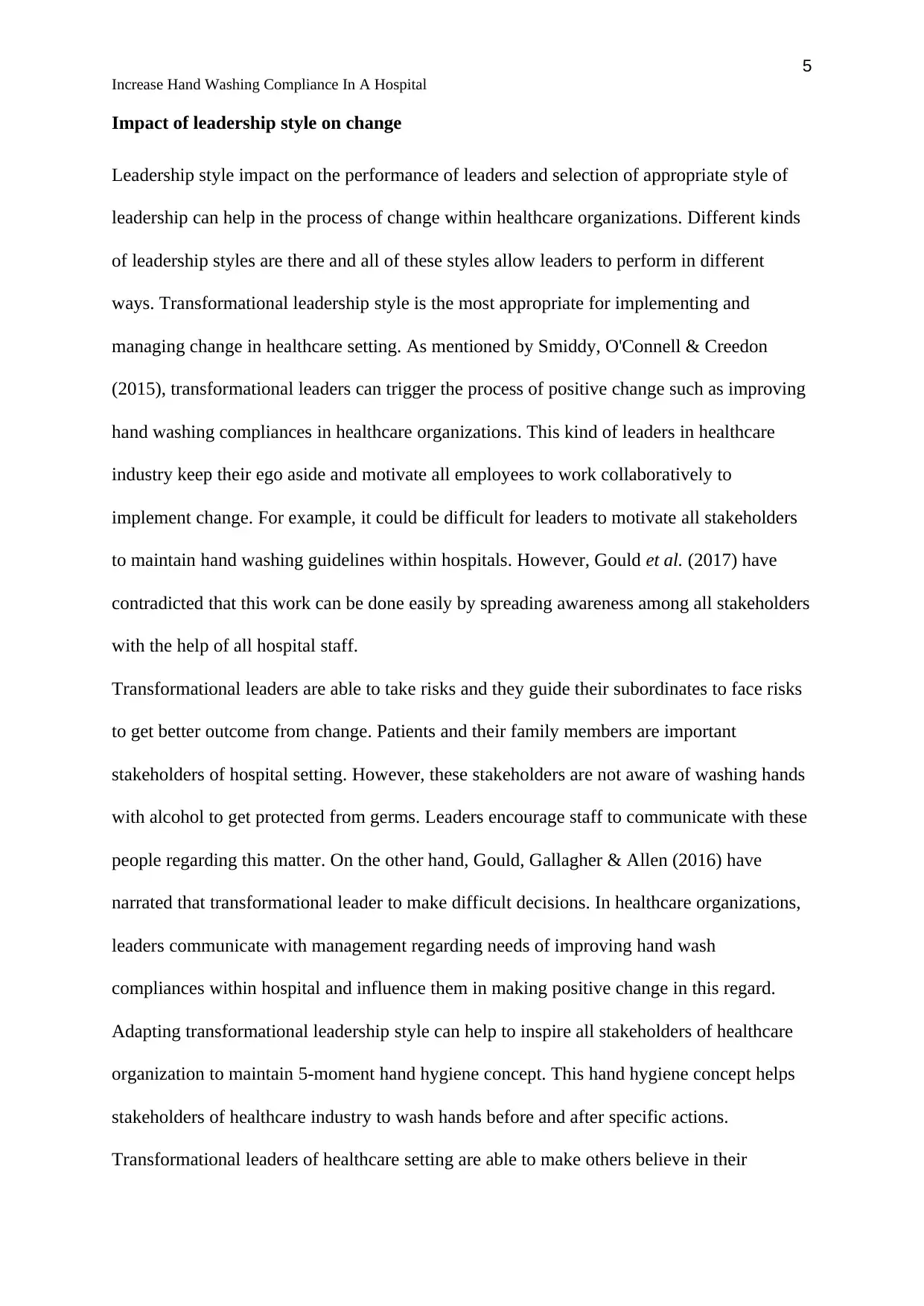
5
Increase Hand Washing Compliance In A Hospital
Impact of leadership style on change
Leadership style impact on the performance of leaders and selection of appropriate style of
leadership can help in the process of change within healthcare organizations. Different kinds
of leadership styles are there and all of these styles allow leaders to perform in different
ways. Transformational leadership style is the most appropriate for implementing and
managing change in healthcare setting. As mentioned by Smiddy, O'Connell & Creedon
(2015), transformational leaders can trigger the process of positive change such as improving
hand washing compliances in healthcare organizations. This kind of leaders in healthcare
industry keep their ego aside and motivate all employees to work collaboratively to
implement change. For example, it could be difficult for leaders to motivate all stakeholders
to maintain hand washing guidelines within hospitals. However, Gould et al. (2017) have
contradicted that this work can be done easily by spreading awareness among all stakeholders
with the help of all hospital staff.
Transformational leaders are able to take risks and they guide their subordinates to face risks
to get better outcome from change. Patients and their family members are important
stakeholders of hospital setting. However, these stakeholders are not aware of washing hands
with alcohol to get protected from germs. Leaders encourage staff to communicate with these
people regarding this matter. On the other hand, Gould, Gallagher & Allen (2016) have
narrated that transformational leader to make difficult decisions. In healthcare organizations,
leaders communicate with management regarding needs of improving hand wash
compliances within hospital and influence them in making positive change in this regard.
Adapting transformational leadership style can help to inspire all stakeholders of healthcare
organization to maintain 5-moment hand hygiene concept. This hand hygiene concept helps
stakeholders of healthcare industry to wash hands before and after specific actions.
Transformational leaders of healthcare setting are able to make others believe in their
Increase Hand Washing Compliance In A Hospital
Impact of leadership style on change
Leadership style impact on the performance of leaders and selection of appropriate style of
leadership can help in the process of change within healthcare organizations. Different kinds
of leadership styles are there and all of these styles allow leaders to perform in different
ways. Transformational leadership style is the most appropriate for implementing and
managing change in healthcare setting. As mentioned by Smiddy, O'Connell & Creedon
(2015), transformational leaders can trigger the process of positive change such as improving
hand washing compliances in healthcare organizations. This kind of leaders in healthcare
industry keep their ego aside and motivate all employees to work collaboratively to
implement change. For example, it could be difficult for leaders to motivate all stakeholders
to maintain hand washing guidelines within hospitals. However, Gould et al. (2017) have
contradicted that this work can be done easily by spreading awareness among all stakeholders
with the help of all hospital staff.
Transformational leaders are able to take risks and they guide their subordinates to face risks
to get better outcome from change. Patients and their family members are important
stakeholders of hospital setting. However, these stakeholders are not aware of washing hands
with alcohol to get protected from germs. Leaders encourage staff to communicate with these
people regarding this matter. On the other hand, Gould, Gallagher & Allen (2016) have
narrated that transformational leader to make difficult decisions. In healthcare organizations,
leaders communicate with management regarding needs of improving hand wash
compliances within hospital and influence them in making positive change in this regard.
Adapting transformational leadership style can help to inspire all stakeholders of healthcare
organization to maintain 5-moment hand hygiene concept. This hand hygiene concept helps
stakeholders of healthcare industry to wash hands before and after specific actions.
Transformational leaders of healthcare setting are able to make others believe in their
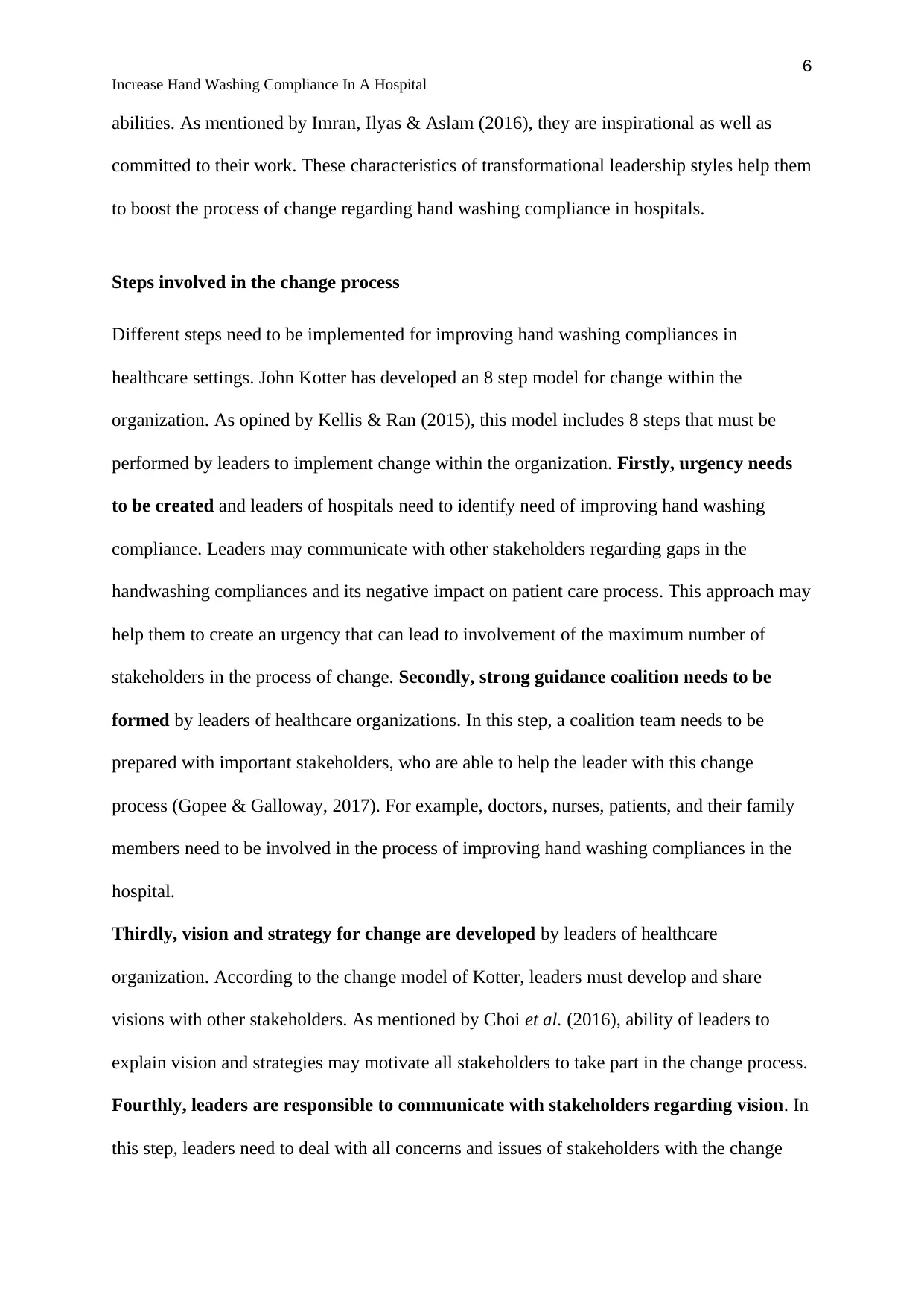
6
Increase Hand Washing Compliance In A Hospital
abilities. As mentioned by Imran, Ilyas & Aslam (2016), they are inspirational as well as
committed to their work. These characteristics of transformational leadership styles help them
to boost the process of change regarding hand washing compliance in hospitals.
Steps involved in the change process
Different steps need to be implemented for improving hand washing compliances in
healthcare settings. John Kotter has developed an 8 step model for change within the
organization. As opined by Kellis & Ran (2015), this model includes 8 steps that must be
performed by leaders to implement change within the organization. Firstly, urgency needs
to be created and leaders of hospitals need to identify need of improving hand washing
compliance. Leaders may communicate with other stakeholders regarding gaps in the
handwashing compliances and its negative impact on patient care process. This approach may
help them to create an urgency that can lead to involvement of the maximum number of
stakeholders in the process of change. Secondly, strong guidance coalition needs to be
formed by leaders of healthcare organizations. In this step, a coalition team needs to be
prepared with important stakeholders, who are able to help the leader with this change
process (Gopee & Galloway, 2017). For example, doctors, nurses, patients, and their family
members need to be involved in the process of improving hand washing compliances in the
hospital.
Thirdly, vision and strategy for change are developed by leaders of healthcare
organization. According to the change model of Kotter, leaders must develop and share
visions with other stakeholders. As mentioned by Choi et al. (2016), ability of leaders to
explain vision and strategies may motivate all stakeholders to take part in the change process.
Fourthly, leaders are responsible to communicate with stakeholders regarding vision. In
this step, leaders need to deal with all concerns and issues of stakeholders with the change
Increase Hand Washing Compliance In A Hospital
abilities. As mentioned by Imran, Ilyas & Aslam (2016), they are inspirational as well as
committed to their work. These characteristics of transformational leadership styles help them
to boost the process of change regarding hand washing compliance in hospitals.
Steps involved in the change process
Different steps need to be implemented for improving hand washing compliances in
healthcare settings. John Kotter has developed an 8 step model for change within the
organization. As opined by Kellis & Ran (2015), this model includes 8 steps that must be
performed by leaders to implement change within the organization. Firstly, urgency needs
to be created and leaders of hospitals need to identify need of improving hand washing
compliance. Leaders may communicate with other stakeholders regarding gaps in the
handwashing compliances and its negative impact on patient care process. This approach may
help them to create an urgency that can lead to involvement of the maximum number of
stakeholders in the process of change. Secondly, strong guidance coalition needs to be
formed by leaders of healthcare organizations. In this step, a coalition team needs to be
prepared with important stakeholders, who are able to help the leader with this change
process (Gopee & Galloway, 2017). For example, doctors, nurses, patients, and their family
members need to be involved in the process of improving hand washing compliances in the
hospital.
Thirdly, vision and strategy for change are developed by leaders of healthcare
organization. According to the change model of Kotter, leaders must develop and share
visions with other stakeholders. As mentioned by Choi et al. (2016), ability of leaders to
explain vision and strategies may motivate all stakeholders to take part in the change process.
Fourthly, leaders are responsible to communicate with stakeholders regarding vision. In
this step, leaders need to deal with all concerns and issues of stakeholders with the change
⊘ This is a preview!⊘
Do you want full access?
Subscribe today to unlock all pages.

Trusted by 1+ million students worldwide
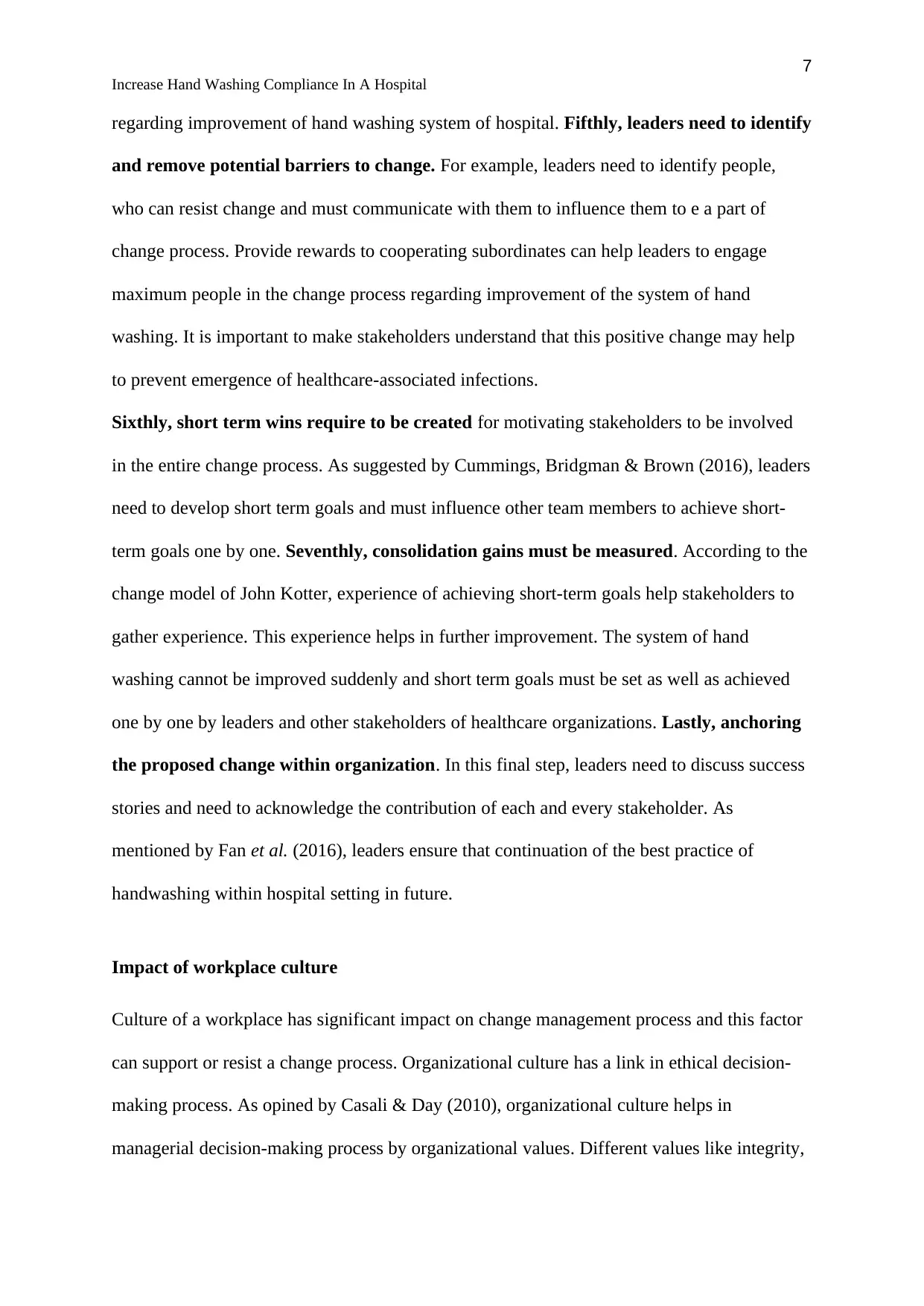
7
Increase Hand Washing Compliance In A Hospital
regarding improvement of hand washing system of hospital. Fifthly, leaders need to identify
and remove potential barriers to change. For example, leaders need to identify people,
who can resist change and must communicate with them to influence them to e a part of
change process. Provide rewards to cooperating subordinates can help leaders to engage
maximum people in the change process regarding improvement of the system of hand
washing. It is important to make stakeholders understand that this positive change may help
to prevent emergence of healthcare-associated infections.
Sixthly, short term wins require to be created for motivating stakeholders to be involved
in the entire change process. As suggested by Cummings, Bridgman & Brown (2016), leaders
need to develop short term goals and must influence other team members to achieve short-
term goals one by one. Seventhly, consolidation gains must be measured. According to the
change model of John Kotter, experience of achieving short-term goals help stakeholders to
gather experience. This experience helps in further improvement. The system of hand
washing cannot be improved suddenly and short term goals must be set as well as achieved
one by one by leaders and other stakeholders of healthcare organizations. Lastly, anchoring
the proposed change within organization. In this final step, leaders need to discuss success
stories and need to acknowledge the contribution of each and every stakeholder. As
mentioned by Fan et al. (2016), leaders ensure that continuation of the best practice of
handwashing within hospital setting in future.
Impact of workplace culture
Culture of a workplace has significant impact on change management process and this factor
can support or resist a change process. Organizational culture has a link in ethical decision-
making process. As opined by Casali & Day (2010), organizational culture helps in
managerial decision-making process by organizational values. Different values like integrity,
Increase Hand Washing Compliance In A Hospital
regarding improvement of hand washing system of hospital. Fifthly, leaders need to identify
and remove potential barriers to change. For example, leaders need to identify people,
who can resist change and must communicate with them to influence them to e a part of
change process. Provide rewards to cooperating subordinates can help leaders to engage
maximum people in the change process regarding improvement of the system of hand
washing. It is important to make stakeholders understand that this positive change may help
to prevent emergence of healthcare-associated infections.
Sixthly, short term wins require to be created for motivating stakeholders to be involved
in the entire change process. As suggested by Cummings, Bridgman & Brown (2016), leaders
need to develop short term goals and must influence other team members to achieve short-
term goals one by one. Seventhly, consolidation gains must be measured. According to the
change model of John Kotter, experience of achieving short-term goals help stakeholders to
gather experience. This experience helps in further improvement. The system of hand
washing cannot be improved suddenly and short term goals must be set as well as achieved
one by one by leaders and other stakeholders of healthcare organizations. Lastly, anchoring
the proposed change within organization. In this final step, leaders need to discuss success
stories and need to acknowledge the contribution of each and every stakeholder. As
mentioned by Fan et al. (2016), leaders ensure that continuation of the best practice of
handwashing within hospital setting in future.
Impact of workplace culture
Culture of a workplace has significant impact on change management process and this factor
can support or resist a change process. Organizational culture has a link in ethical decision-
making process. As opined by Casali & Day (2010), organizational culture helps in
managerial decision-making process by organizational values. Different values like integrity,
Paraphrase This Document
Need a fresh take? Get an instant paraphrase of this document with our AI Paraphraser
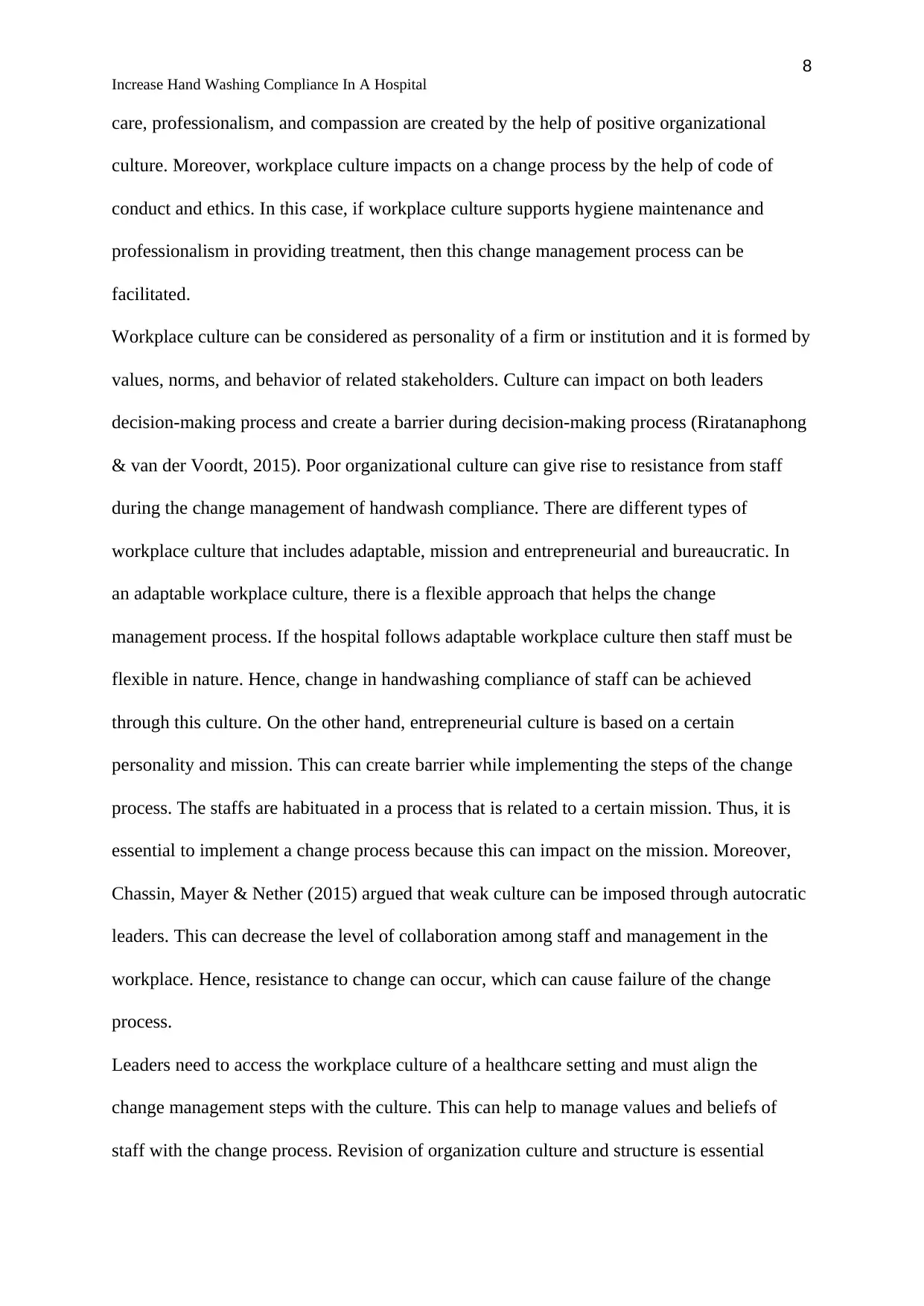
8
Increase Hand Washing Compliance In A Hospital
care, professionalism, and compassion are created by the help of positive organizational
culture. Moreover, workplace culture impacts on a change process by the help of code of
conduct and ethics. In this case, if workplace culture supports hygiene maintenance and
professionalism in providing treatment, then this change management process can be
facilitated.
Workplace culture can be considered as personality of a firm or institution and it is formed by
values, norms, and behavior of related stakeholders. Culture can impact on both leaders
decision-making process and create a barrier during decision-making process (Riratanaphong
& van der Voordt, 2015). Poor organizational culture can give rise to resistance from staff
during the change management of handwash compliance. There are different types of
workplace culture that includes adaptable, mission and entrepreneurial and bureaucratic. In
an adaptable workplace culture, there is a flexible approach that helps the change
management process. If the hospital follows adaptable workplace culture then staff must be
flexible in nature. Hence, change in handwashing compliance of staff can be achieved
through this culture. On the other hand, entrepreneurial culture is based on a certain
personality and mission. This can create barrier while implementing the steps of the change
process. The staffs are habituated in a process that is related to a certain mission. Thus, it is
essential to implement a change process because this can impact on the mission. Moreover,
Chassin, Mayer & Nether (2015) argued that weak culture can be imposed through autocratic
leaders. This can decrease the level of collaboration among staff and management in the
workplace. Hence, resistance to change can occur, which can cause failure of the change
process.
Leaders need to access the workplace culture of a healthcare setting and must align the
change management steps with the culture. This can help to manage values and beliefs of
staff with the change process. Revision of organization culture and structure is essential
Increase Hand Washing Compliance In A Hospital
care, professionalism, and compassion are created by the help of positive organizational
culture. Moreover, workplace culture impacts on a change process by the help of code of
conduct and ethics. In this case, if workplace culture supports hygiene maintenance and
professionalism in providing treatment, then this change management process can be
facilitated.
Workplace culture can be considered as personality of a firm or institution and it is formed by
values, norms, and behavior of related stakeholders. Culture can impact on both leaders
decision-making process and create a barrier during decision-making process (Riratanaphong
& van der Voordt, 2015). Poor organizational culture can give rise to resistance from staff
during the change management of handwash compliance. There are different types of
workplace culture that includes adaptable, mission and entrepreneurial and bureaucratic. In
an adaptable workplace culture, there is a flexible approach that helps the change
management process. If the hospital follows adaptable workplace culture then staff must be
flexible in nature. Hence, change in handwashing compliance of staff can be achieved
through this culture. On the other hand, entrepreneurial culture is based on a certain
personality and mission. This can create barrier while implementing the steps of the change
process. The staffs are habituated in a process that is related to a certain mission. Thus, it is
essential to implement a change process because this can impact on the mission. Moreover,
Chassin, Mayer & Nether (2015) argued that weak culture can be imposed through autocratic
leaders. This can decrease the level of collaboration among staff and management in the
workplace. Hence, resistance to change can occur, which can cause failure of the change
process.
Leaders need to access the workplace culture of a healthcare setting and must align the
change management steps with the culture. This can help to manage values and beliefs of
staff with the change process. Revision of organization culture and structure is essential
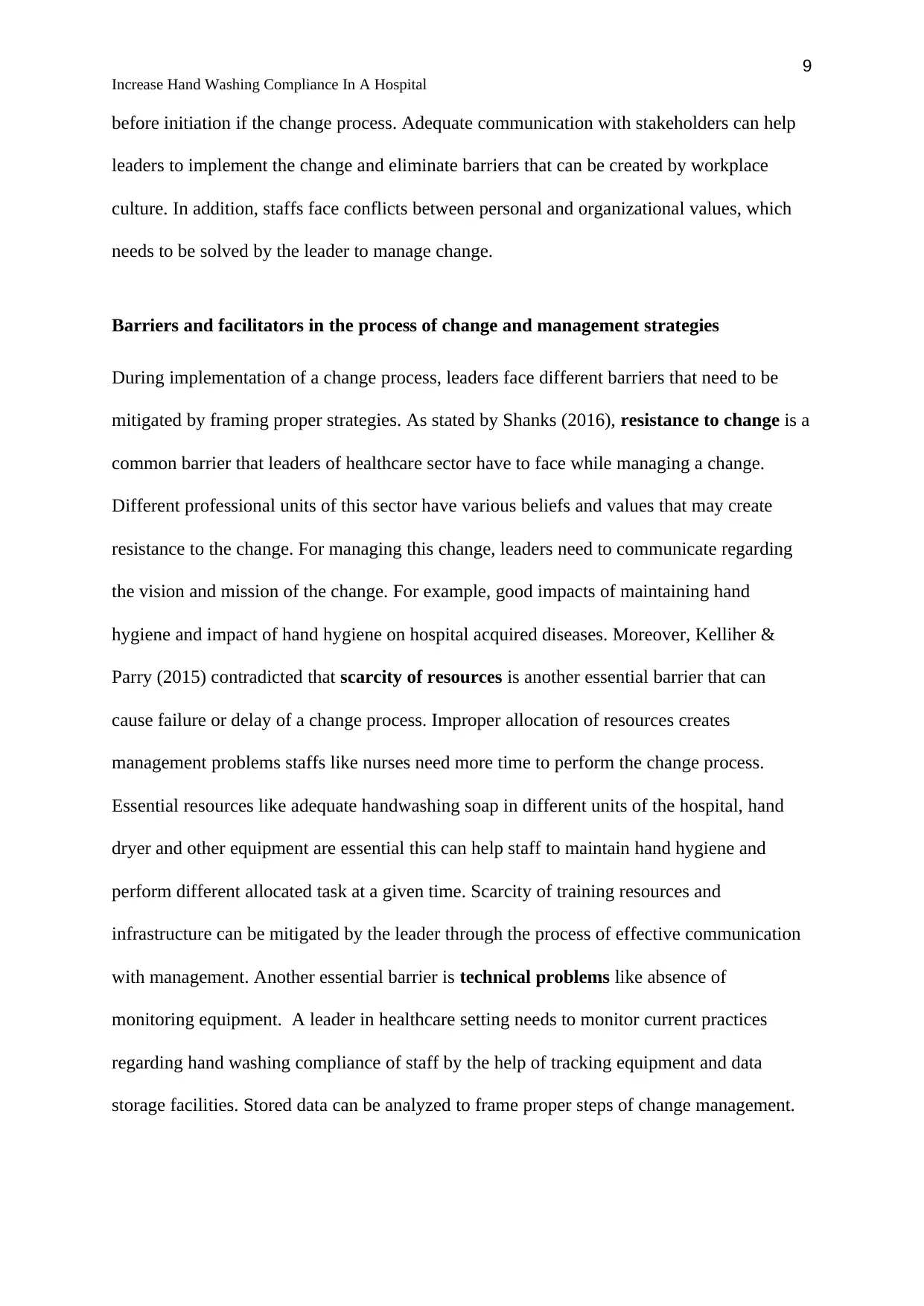
9
Increase Hand Washing Compliance In A Hospital
before initiation if the change process. Adequate communication with stakeholders can help
leaders to implement the change and eliminate barriers that can be created by workplace
culture. In addition, staffs face conflicts between personal and organizational values, which
needs to be solved by the leader to manage change.
Barriers and facilitators in the process of change and management strategies
During implementation of a change process, leaders face different barriers that need to be
mitigated by framing proper strategies. As stated by Shanks (2016), resistance to change is a
common barrier that leaders of healthcare sector have to face while managing a change.
Different professional units of this sector have various beliefs and values that may create
resistance to the change. For managing this change, leaders need to communicate regarding
the vision and mission of the change. For example, good impacts of maintaining hand
hygiene and impact of hand hygiene on hospital acquired diseases. Moreover, Kelliher &
Parry (2015) contradicted that scarcity of resources is another essential barrier that can
cause failure or delay of a change process. Improper allocation of resources creates
management problems staffs like nurses need more time to perform the change process.
Essential resources like adequate handwashing soap in different units of the hospital, hand
dryer and other equipment are essential this can help staff to maintain hand hygiene and
perform different allocated task at a given time. Scarcity of training resources and
infrastructure can be mitigated by the leader through the process of effective communication
with management. Another essential barrier is technical problems like absence of
monitoring equipment. A leader in healthcare setting needs to monitor current practices
regarding hand washing compliance of staff by the help of tracking equipment and data
storage facilities. Stored data can be analyzed to frame proper steps of change management.
Increase Hand Washing Compliance In A Hospital
before initiation if the change process. Adequate communication with stakeholders can help
leaders to implement the change and eliminate barriers that can be created by workplace
culture. In addition, staffs face conflicts between personal and organizational values, which
needs to be solved by the leader to manage change.
Barriers and facilitators in the process of change and management strategies
During implementation of a change process, leaders face different barriers that need to be
mitigated by framing proper strategies. As stated by Shanks (2016), resistance to change is a
common barrier that leaders of healthcare sector have to face while managing a change.
Different professional units of this sector have various beliefs and values that may create
resistance to the change. For managing this change, leaders need to communicate regarding
the vision and mission of the change. For example, good impacts of maintaining hand
hygiene and impact of hand hygiene on hospital acquired diseases. Moreover, Kelliher &
Parry (2015) contradicted that scarcity of resources is another essential barrier that can
cause failure or delay of a change process. Improper allocation of resources creates
management problems staffs like nurses need more time to perform the change process.
Essential resources like adequate handwashing soap in different units of the hospital, hand
dryer and other equipment are essential this can help staff to maintain hand hygiene and
perform different allocated task at a given time. Scarcity of training resources and
infrastructure can be mitigated by the leader through the process of effective communication
with management. Another essential barrier is technical problems like absence of
monitoring equipment. A leader in healthcare setting needs to monitor current practices
regarding hand washing compliance of staff by the help of tracking equipment and data
storage facilities. Stored data can be analyzed to frame proper steps of change management.
⊘ This is a preview!⊘
Do you want full access?
Subscribe today to unlock all pages.

Trusted by 1+ million students worldwide
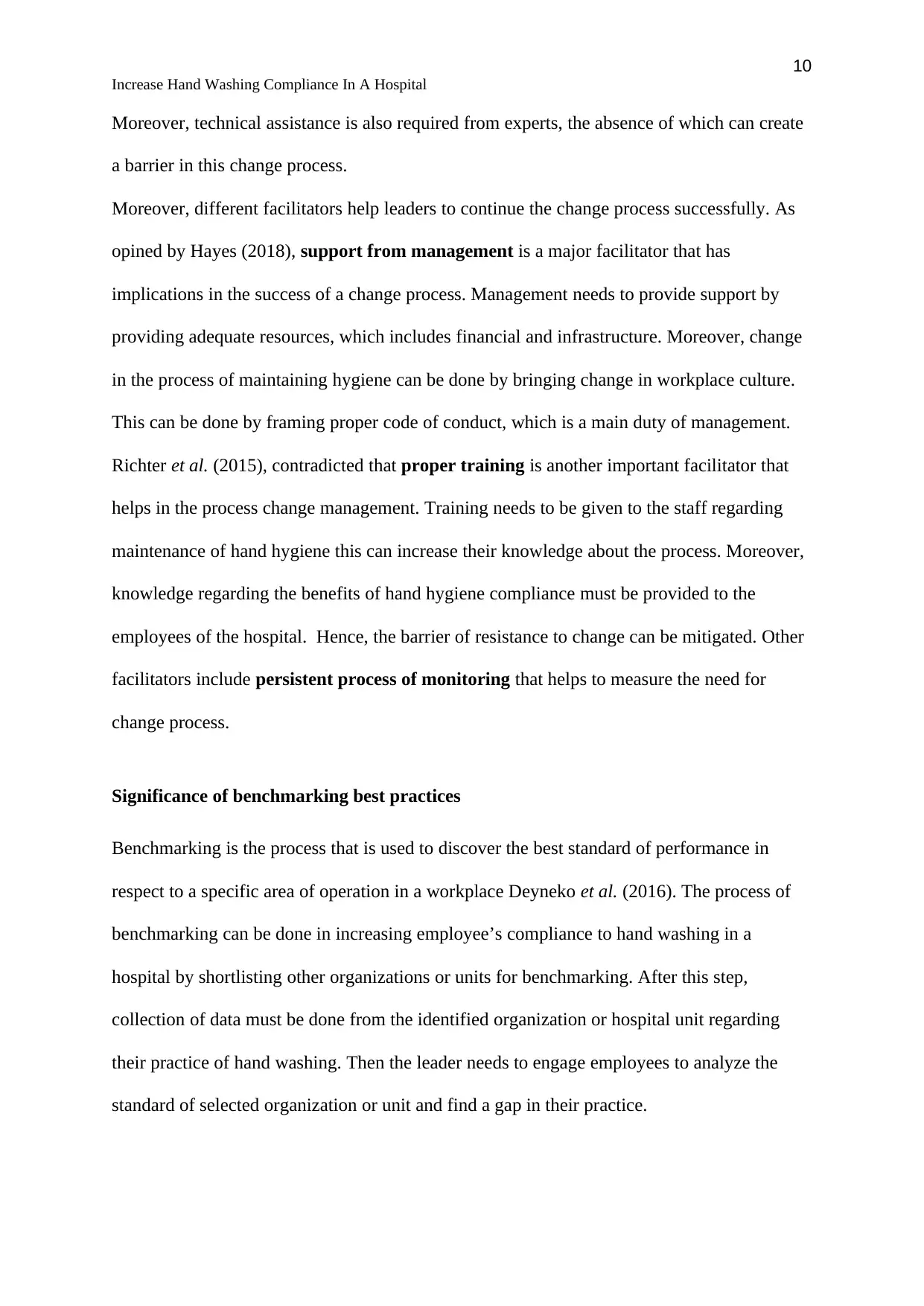
10
Increase Hand Washing Compliance In A Hospital
Moreover, technical assistance is also required from experts, the absence of which can create
a barrier in this change process.
Moreover, different facilitators help leaders to continue the change process successfully. As
opined by Hayes (2018), support from management is a major facilitator that has
implications in the success of a change process. Management needs to provide support by
providing adequate resources, which includes financial and infrastructure. Moreover, change
in the process of maintaining hygiene can be done by bringing change in workplace culture.
This can be done by framing proper code of conduct, which is a main duty of management.
Richter et al. (2015), contradicted that proper training is another important facilitator that
helps in the process change management. Training needs to be given to the staff regarding
maintenance of hand hygiene this can increase their knowledge about the process. Moreover,
knowledge regarding the benefits of hand hygiene compliance must be provided to the
employees of the hospital. Hence, the barrier of resistance to change can be mitigated. Other
facilitators include persistent process of monitoring that helps to measure the need for
change process.
Significance of benchmarking best practices
Benchmarking is the process that is used to discover the best standard of performance in
respect to a specific area of operation in a workplace Deyneko et al. (2016). The process of
benchmarking can be done in increasing employee’s compliance to hand washing in a
hospital by shortlisting other organizations or units for benchmarking. After this step,
collection of data must be done from the identified organization or hospital unit regarding
their practice of hand washing. Then the leader needs to engage employees to analyze the
standard of selected organization or unit and find a gap in their practice.
Increase Hand Washing Compliance In A Hospital
Moreover, technical assistance is also required from experts, the absence of which can create
a barrier in this change process.
Moreover, different facilitators help leaders to continue the change process successfully. As
opined by Hayes (2018), support from management is a major facilitator that has
implications in the success of a change process. Management needs to provide support by
providing adequate resources, which includes financial and infrastructure. Moreover, change
in the process of maintaining hygiene can be done by bringing change in workplace culture.
This can be done by framing proper code of conduct, which is a main duty of management.
Richter et al. (2015), contradicted that proper training is another important facilitator that
helps in the process change management. Training needs to be given to the staff regarding
maintenance of hand hygiene this can increase their knowledge about the process. Moreover,
knowledge regarding the benefits of hand hygiene compliance must be provided to the
employees of the hospital. Hence, the barrier of resistance to change can be mitigated. Other
facilitators include persistent process of monitoring that helps to measure the need for
change process.
Significance of benchmarking best practices
Benchmarking is the process that is used to discover the best standard of performance in
respect to a specific area of operation in a workplace Deyneko et al. (2016). The process of
benchmarking can be done in increasing employee’s compliance to hand washing in a
hospital by shortlisting other organizations or units for benchmarking. After this step,
collection of data must be done from the identified organization or hospital unit regarding
their practice of hand washing. Then the leader needs to engage employees to analyze the
standard of selected organization or unit and find a gap in their practice.
Paraphrase This Document
Need a fresh take? Get an instant paraphrase of this document with our AI Paraphraser
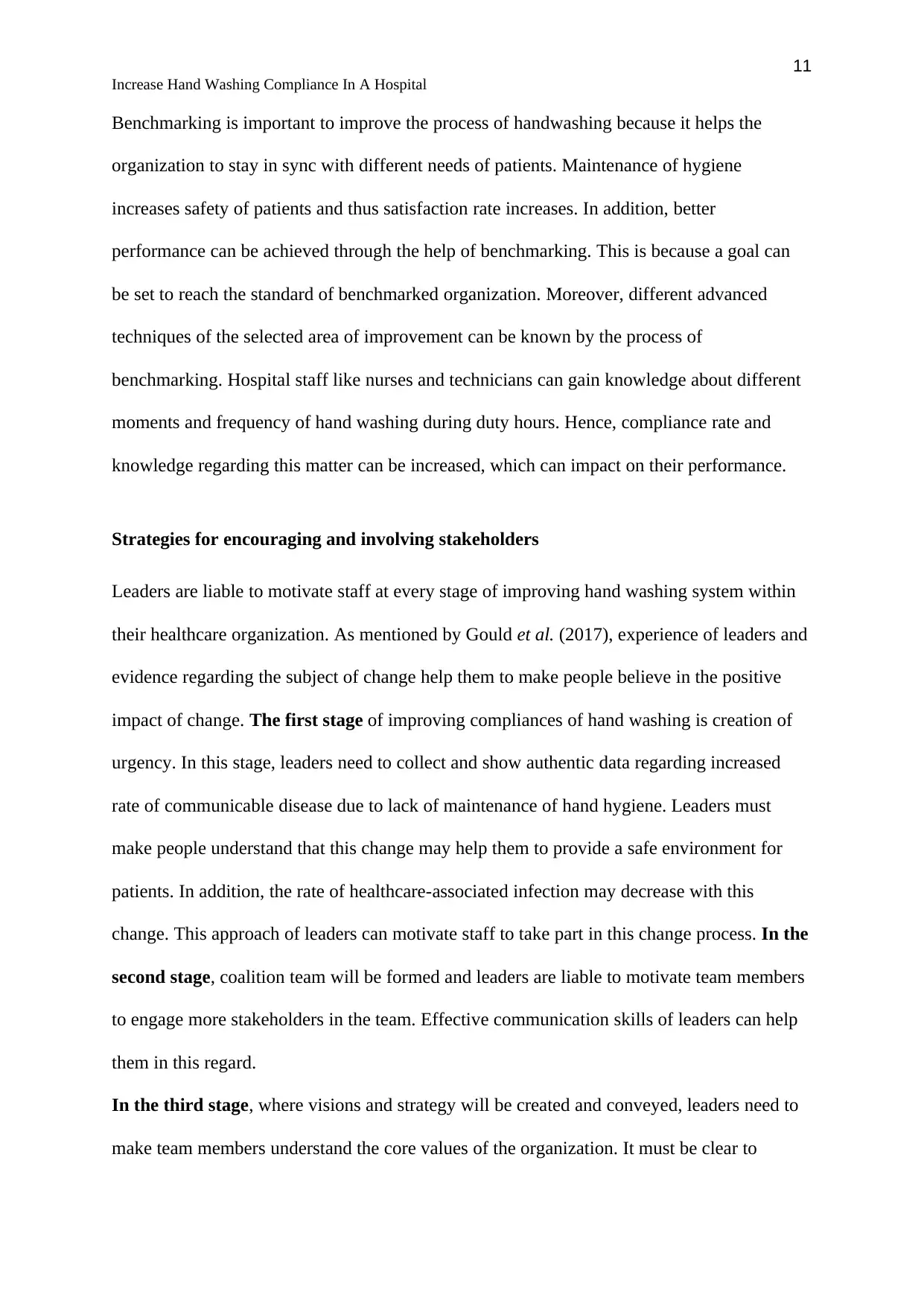
11
Increase Hand Washing Compliance In A Hospital
Benchmarking is important to improve the process of handwashing because it helps the
organization to stay in sync with different needs of patients. Maintenance of hygiene
increases safety of patients and thus satisfaction rate increases. In addition, better
performance can be achieved through the help of benchmarking. This is because a goal can
be set to reach the standard of benchmarked organization. Moreover, different advanced
techniques of the selected area of improvement can be known by the process of
benchmarking. Hospital staff like nurses and technicians can gain knowledge about different
moments and frequency of hand washing during duty hours. Hence, compliance rate and
knowledge regarding this matter can be increased, which can impact on their performance.
Strategies for encouraging and involving stakeholders
Leaders are liable to motivate staff at every stage of improving hand washing system within
their healthcare organization. As mentioned by Gould et al. (2017), experience of leaders and
evidence regarding the subject of change help them to make people believe in the positive
impact of change. The first stage of improving compliances of hand washing is creation of
urgency. In this stage, leaders need to collect and show authentic data regarding increased
rate of communicable disease due to lack of maintenance of hand hygiene. Leaders must
make people understand that this change may help them to provide a safe environment for
patients. In addition, the rate of healthcare-associated infection may decrease with this
change. This approach of leaders can motivate staff to take part in this change process. In the
second stage, coalition team will be formed and leaders are liable to motivate team members
to engage more stakeholders in the team. Effective communication skills of leaders can help
them in this regard.
In the third stage, where visions and strategy will be created and conveyed, leaders need to
make team members understand the core values of the organization. It must be clear to
Increase Hand Washing Compliance In A Hospital
Benchmarking is important to improve the process of handwashing because it helps the
organization to stay in sync with different needs of patients. Maintenance of hygiene
increases safety of patients and thus satisfaction rate increases. In addition, better
performance can be achieved through the help of benchmarking. This is because a goal can
be set to reach the standard of benchmarked organization. Moreover, different advanced
techniques of the selected area of improvement can be known by the process of
benchmarking. Hospital staff like nurses and technicians can gain knowledge about different
moments and frequency of hand washing during duty hours. Hence, compliance rate and
knowledge regarding this matter can be increased, which can impact on their performance.
Strategies for encouraging and involving stakeholders
Leaders are liable to motivate staff at every stage of improving hand washing system within
their healthcare organization. As mentioned by Gould et al. (2017), experience of leaders and
evidence regarding the subject of change help them to make people believe in the positive
impact of change. The first stage of improving compliances of hand washing is creation of
urgency. In this stage, leaders need to collect and show authentic data regarding increased
rate of communicable disease due to lack of maintenance of hand hygiene. Leaders must
make people understand that this change may help them to provide a safe environment for
patients. In addition, the rate of healthcare-associated infection may decrease with this
change. This approach of leaders can motivate staff to take part in this change process. In the
second stage, coalition team will be formed and leaders are liable to motivate team members
to engage more stakeholders in the team. Effective communication skills of leaders can help
them in this regard.
In the third stage, where visions and strategy will be created and conveyed, leaders need to
make team members understand the core values of the organization. It must be clear to
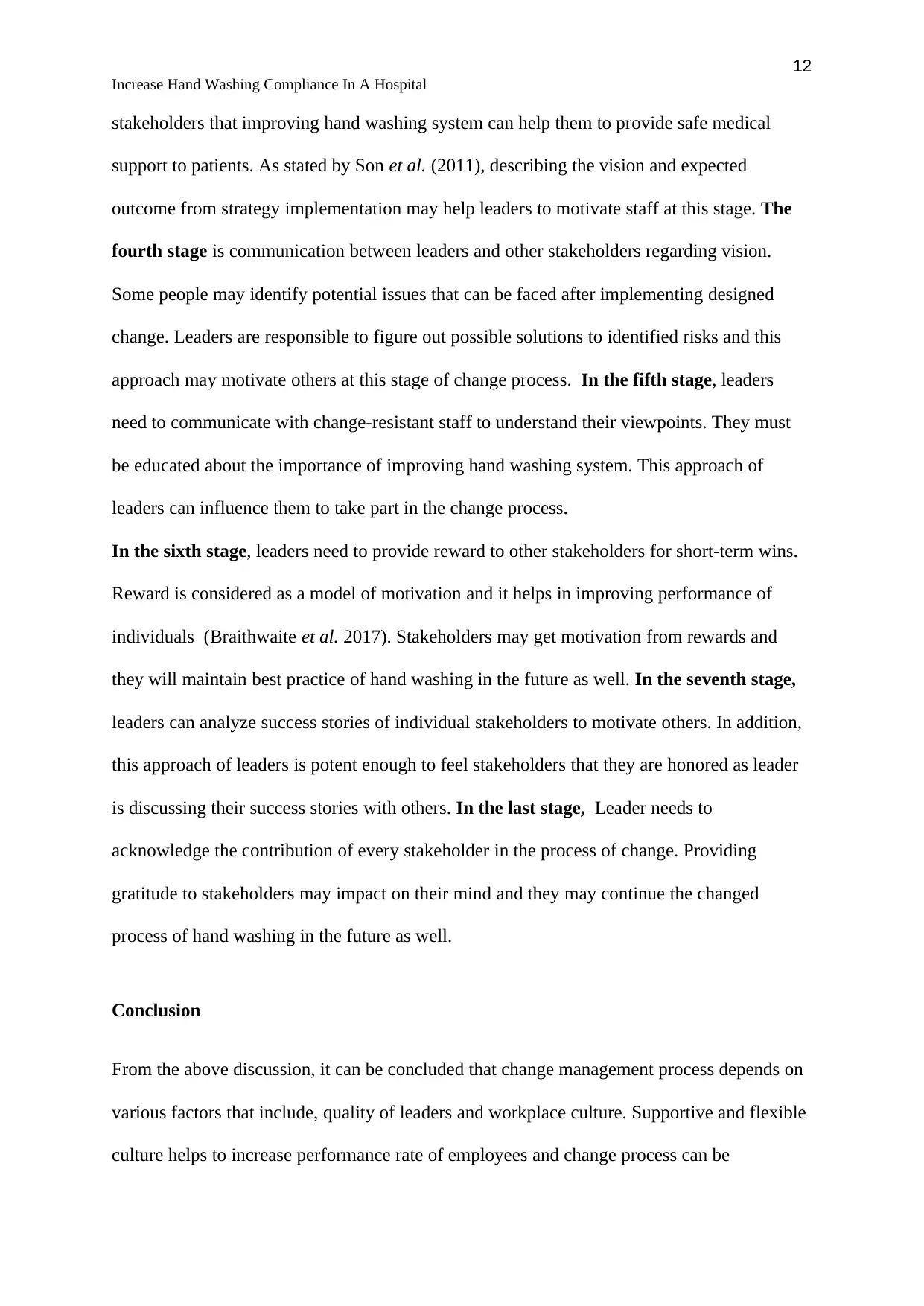
12
Increase Hand Washing Compliance In A Hospital
stakeholders that improving hand washing system can help them to provide safe medical
support to patients. As stated by Son et al. (2011), describing the vision and expected
outcome from strategy implementation may help leaders to motivate staff at this stage. The
fourth stage is communication between leaders and other stakeholders regarding vision.
Some people may identify potential issues that can be faced after implementing designed
change. Leaders are responsible to figure out possible solutions to identified risks and this
approach may motivate others at this stage of change process. In the fifth stage, leaders
need to communicate with change-resistant staff to understand their viewpoints. They must
be educated about the importance of improving hand washing system. This approach of
leaders can influence them to take part in the change process.
In the sixth stage, leaders need to provide reward to other stakeholders for short-term wins.
Reward is considered as a model of motivation and it helps in improving performance of
individuals (Braithwaite et al. 2017). Stakeholders may get motivation from rewards and
they will maintain best practice of hand washing in the future as well. In the seventh stage,
leaders can analyze success stories of individual stakeholders to motivate others. In addition,
this approach of leaders is potent enough to feel stakeholders that they are honored as leader
is discussing their success stories with others. In the last stage, Leader needs to
acknowledge the contribution of every stakeholder in the process of change. Providing
gratitude to stakeholders may impact on their mind and they may continue the changed
process of hand washing in the future as well.
Conclusion
From the above discussion, it can be concluded that change management process depends on
various factors that include, quality of leaders and workplace culture. Supportive and flexible
culture helps to increase performance rate of employees and change process can be
Increase Hand Washing Compliance In A Hospital
stakeholders that improving hand washing system can help them to provide safe medical
support to patients. As stated by Son et al. (2011), describing the vision and expected
outcome from strategy implementation may help leaders to motivate staff at this stage. The
fourth stage is communication between leaders and other stakeholders regarding vision.
Some people may identify potential issues that can be faced after implementing designed
change. Leaders are responsible to figure out possible solutions to identified risks and this
approach may motivate others at this stage of change process. In the fifth stage, leaders
need to communicate with change-resistant staff to understand their viewpoints. They must
be educated about the importance of improving hand washing system. This approach of
leaders can influence them to take part in the change process.
In the sixth stage, leaders need to provide reward to other stakeholders for short-term wins.
Reward is considered as a model of motivation and it helps in improving performance of
individuals (Braithwaite et al. 2017). Stakeholders may get motivation from rewards and
they will maintain best practice of hand washing in the future as well. In the seventh stage,
leaders can analyze success stories of individual stakeholders to motivate others. In addition,
this approach of leaders is potent enough to feel stakeholders that they are honored as leader
is discussing their success stories with others. In the last stage, Leader needs to
acknowledge the contribution of every stakeholder in the process of change. Providing
gratitude to stakeholders may impact on their mind and they may continue the changed
process of hand washing in the future as well.
Conclusion
From the above discussion, it can be concluded that change management process depends on
various factors that include, quality of leaders and workplace culture. Supportive and flexible
culture helps to increase performance rate of employees and change process can be
⊘ This is a preview!⊘
Do you want full access?
Subscribe today to unlock all pages.

Trusted by 1+ million students worldwide
1 out of 18
Related Documents
Your All-in-One AI-Powered Toolkit for Academic Success.
+13062052269
info@desklib.com
Available 24*7 on WhatsApp / Email
![[object Object]](/_next/static/media/star-bottom.7253800d.svg)
Unlock your academic potential
Copyright © 2020–2025 A2Z Services. All Rights Reserved. Developed and managed by ZUCOL.





